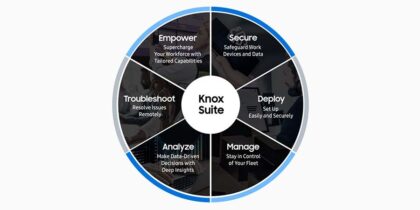If there’s a bright future in enterprise computing, it looks a lot like a smartphone.
More precisely, it looks like a smartphone not tethered to a desktop, workplace or particular location: something with wireless connectivity to critical information, empowering staff to make smarter and faster decisions, to provide better service to customers and clients, and to keep teams better informed with less effort. That’s mobility.
Some will stumble into enterprise mobility, moving through BYOD, COPE and CYOD stages, gradually porting applications from their VPN to the internet, creating responsive user interfaces, and treating mobility as a “demand pull” technology. That approach may work out in the long run, but it can also be slow, expensive and error-prone.
Pushing Mobility Strategically
Smart enterprises will step back and build a mobility strategy that tries to shortcut common errors, accelerate building and deployment of applications, and take advantage of an optimized path to a more mobile workforce. A “supply push” strategy puts the enterprise in control. When an enterprise has a mobility strategy in place, driven from the top levels, it sets the tone and agenda for everything from application development to BYOD/CYOD strategy, and helps groups throughout the organization understand what processes need to change.
More importantly, a well-designed mobility strategy helps to ensure that different workgroups can operate in parallel with minimum conflict and redundancy. By being aware of the long-term plan for mobility, groups can come together to build a proper BYOD policy that anticipates what will be needed for a more mobile future.
Having a mobility strategy also helps tame mobility’s shadowy alter-ego: security. Every time someone picks up a smartphone in a crowded restaurant and looks at sensitive customer data, a security expert experiences a twinge of panic. Avoiding catastrophe requires getting the tensions associated with mobility out in the open. If security teams have input as the rest of the enterprise is looking at new models for data access, everyone’s concerns and requirements can be balanced early on, rather than as a show-stopper just before a mobile application is about to be released.
Key Policy Elements
Mobility strategy can look like lots of different things, but the form should reflect the objective: get the organization moving together towards a common end state emphasizing the idea of mobility. Generally, this means that for most enterprises, the strategy should include specific goals, a proposed path to meet them, and some way of measuring success.
A mobility strategy document starts by identifying the major goals you’re trying to accomplish. Whether it’s shortening transaction times, empowering direct sales teams with better tools, or reducing the need for people to sit down at their desks to stay in touch, the strategy document begins with the big picture of where you’re going — but not necessarily how you hope to get there.
Plan a Successful CYOD Program
Download our comprehensive 8-step guide to planning and deploying a CYOD initiative at your company. Download Now
Next, a good strategy document will have some advice on how to meet those goals. This probably includes changes in major applications, development of new applications, changes in data access rules, and even changes in internal processes. This part of the strategy will be subject to change — mobility is nothing if not fast-moving, and even faster-changing. But proposing a general path forward will help to cement what the goals really mean in the most practical sense.
Finally, there should be some way of measuring success in meeting each of the goals. Key performance metrics could range from the number of devices in operation, to numbers or percentages of transactions handled through mobile devices, to satisfaction or speed ratings, to ability to avoid other costs such as office space rentals. The metrics don’t have to be defined down to the decimal point, but they serve as good guides for people acting on the mobility strategy to know whether they’re going in the right direction.
Starting in the Middle
Many — perhaps most — enterprises already have some mobility happening, whether there’s a strategy or not. Office 365, which is inherently mobile-enabled, has more than 125 million subscribers. That’s a whole lot of mobility focused on the enterprise space, with or without a strategy document.
Just because people are already going everywhere with their smartphones doesn’t mean you don’t need to work on a strategy. In fact, you could argue that getting a strategy now is even more important, as it can avoid heading too far in the wrong direction. Certainly, anyone reviewing or updating their BYOD policy should be looking first to see if they’ve got a mobility strategy document to provide guidance.
IT managers are often at the forefront of mobility initiatives, and the excitement of building and deploying mobility may make it hard to put on the brakes. But without an overarching strategy, missteps will come early and often.
Download our free guide and template for everything you need to get started writing your BYOD policy, or learn to design and roll out a comprehensive Choose Your Own Device (CYOD) plan in this free white paper.







